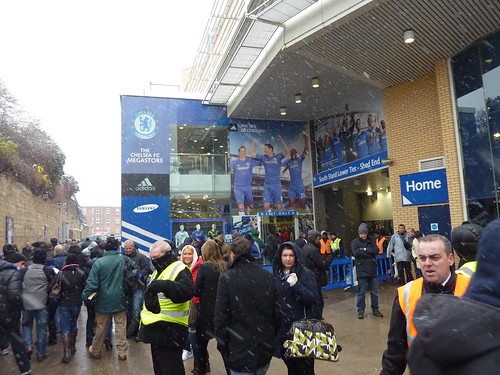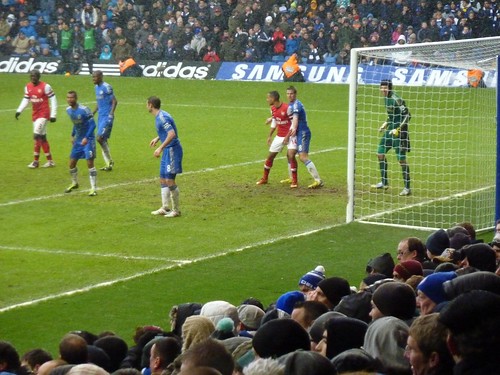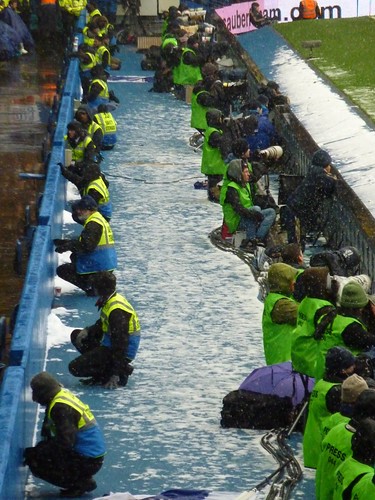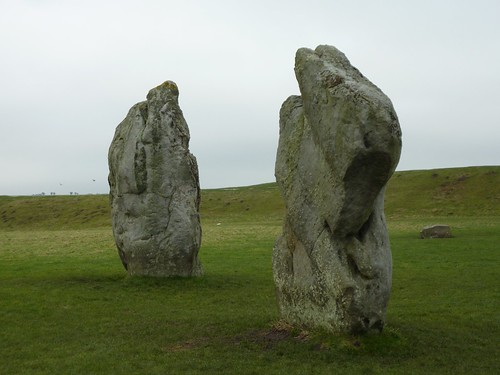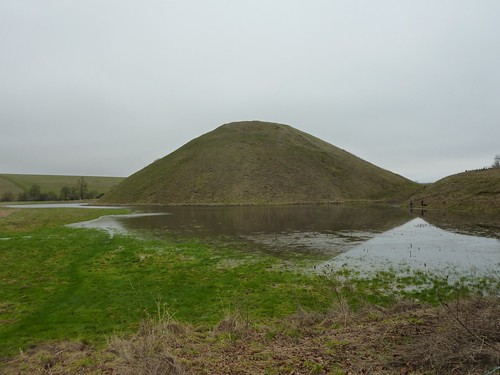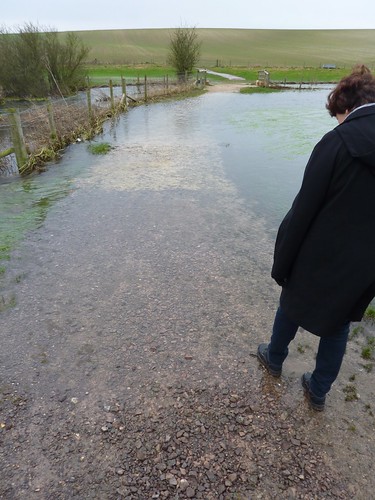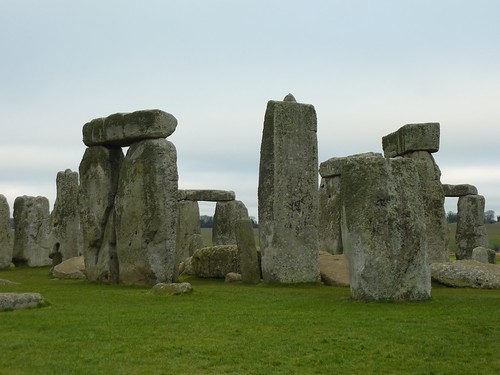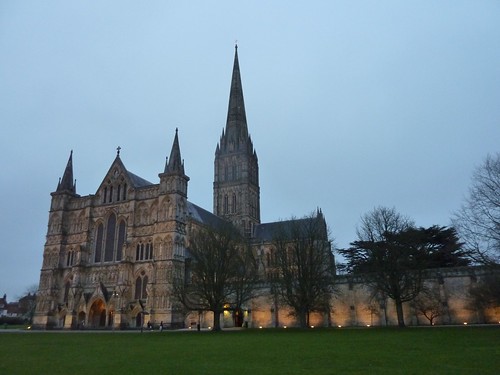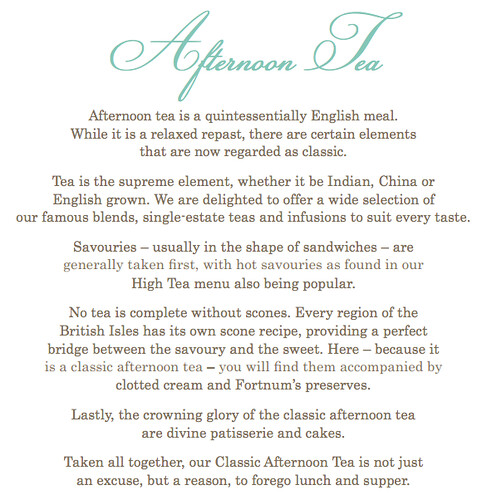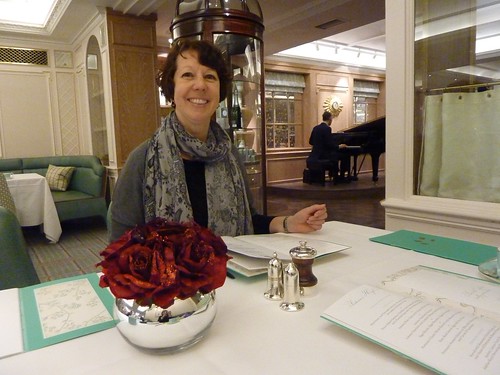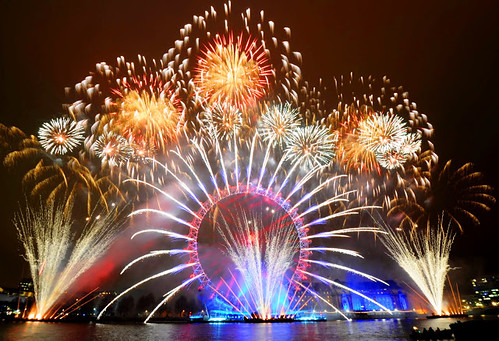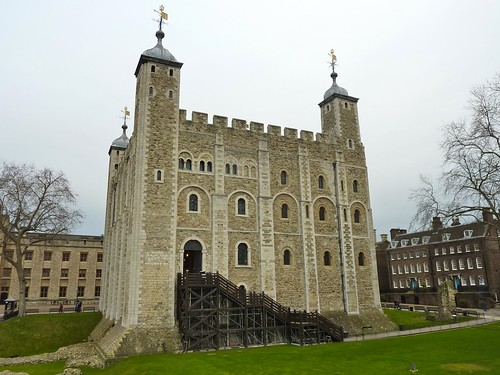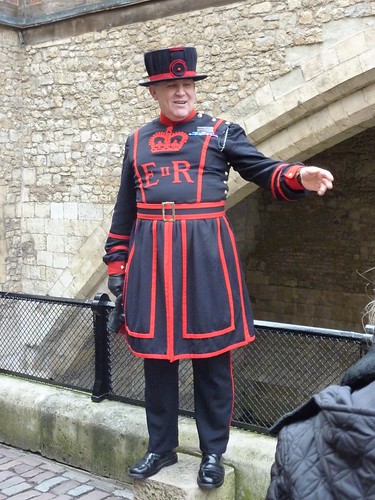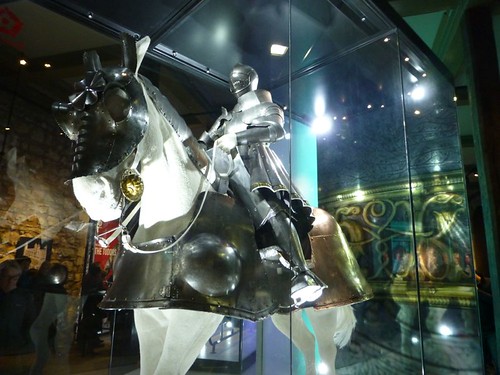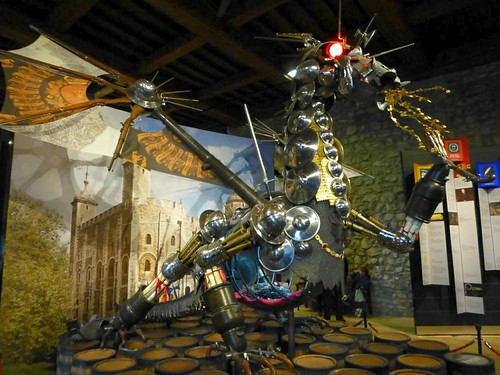It was a real stroke of luck, the fact that the first football match I've ever attended ended up being not just a Premiere League game, but a game between Chelsea and Arsenal, a somewhat classic rivalry. It was thanks to the triplets, of course. The wife of a friend of a friend recently gave birth to triplets, hence the friend of a friend, who has Chelsea season tickets, won't be allowed out of the house until approximately 2028, hence the tickets were offered to my friend Jeremy, who kindly invited me along. Thus it was that I found myself sitting in the stands at Chelsea's famous grounds - Stamford Bridge - on the snowiest Saturday London has seen in a very long time.
English League football is a massive system of interconnected leagues playing in what's often described as a pyramid structure, with the very best teams at the top of the pyramid, and more and more weaker and weaker teams making up the base. At the heart of the system is the concept of promotion and relegation. The teams at each level of play are not fixed at that level but can move up to the next level or down to the level below, depending on their performance each season. Usually the top three in each division are promoted and the bottom three relegated each year.
Most people are familiar with the Premiere League, which is made up of the top 20 teams in the country. Below that is the League Championship, then League One and League Two (Old timers will known these all as Divisions One, Two, Three and Four, but those names were not sexy enough for TV.) Together these four divisions comprise the professional clubs. However, below that are another TWENTY layers comprising a total of more than 140 leagues, 480 divisions and nearly 7,000 teams. It is a BIG pyramid. In fact, England has far more football clubs than any other country in the world, regardless of size or population. (This is similar to Canada's stats on hockey. Canada has more than 10 times as many registered hockey players per capita than any other country.)
The most beautiful thing about the English football league is that the super-highly paid professional players for Chelsea and Arsenal and Manchester United and such are in the same overall system as a small village team like Puddlemere United Amateur Men's Saturday Football Club and Benevolent Association. It's kind of charming. And, if Puddlemere really pulled their socks up and worked their way up to at least the tenth layer, they might eventually end up competing against a Premiere League team for the Football Association Cup, better known as the FA Cup, which is the grand prize in English League football. It's a bit like the Montreal Canadiens playing a beer league team from Porcupine Plains for the Stanley Cup. I love that.
(There are actually other rules that might eliminate Puddlemere from mounting a challenge for the FA Cup, such as the lack of an appropriate stadium for hosting home games, but let's not allow that to cloud the essentially egalitarian nature of the whole thing.)
So that's the English league system. Zillions of teams, promotion, relegation, FA Cup. The other thing that's always puzzled me is why Premiere League teams occasionally hop over to the continent to play Real Madrid or Bayern Munich. It turns out that the English League is part of another, larger league you may have heard of - the Union of European Football Associations, better known as UEFA. The top four teams in the Premiere League play against the top teams in the leagues of other European countries, competing in the UEFA Champions League (Particularly confusing for those who've just got it sorted out that the ChampionSHIP League is the second tier of the English Football League. Try to stay with me.) Again, I find this strange. To trot out the hockey analogy again, this would be like the Edmonton Oilers hopping over to Finland to play one of the top Finnish club teams, in parallel with the regular season.
Having got all that sorted out, let's get back to Stamford Bridge, home of Chelsea FC. Jeremy and I fetched up there after a drink in the Chelsea Ram, an appropriately partisan pub en route to the grounds. (Correct terminology here: football is played on a pitch not a field, and the stadium is often called the grounds). We had tickets in The Shed, which is the nickname for the south stands and home to the most ardent Chelsea supporters. I was expecting to spend the afternoon slowly perishing from hypothermia - it wasn't THAT cold, but anyone who's attended a CFL game knows that sitting mostly motionless in an open stadium during a snowstorm is not the most comfortable experience. Luckily, it turned out that our seats were quite sheltered, and much warmer than expected.
I'd actually been worried that the game might be cancelled - it was snowing quite heavily, and it just didn't seem likely that men in shorts would take to that sort of thing. However, apparently the revenue that Premiere League teams get from television rights is so great that they go to some lengths to ensure that weather is not a factor. This means that the pitch itself is heated to prevent snow building up, which seems highly extravagant in this climate, but nonetheless did the job, as you can see.
Sitting in The Shed was fun. The Chelsea supporters had an impressive repertoire of chants that they employed for the entire game. Some were quite simple, like the old favourite "Chelsea, Chelsea, Chelsea, Chelsea, Chelsea, Chelsea... etc." sung to the tune of Auld Lang Syne. Along with that was the popular "We know who we are! We know who we are! Champions or Europe! We know who we are!" (This because Chelsea won the aforementioned UEFA Champions League in 2012.)
The game was enjoyable and though I've never been a big fan of football, I was impressed with the ball control those guys exhibit. And I managed to get a reasonable grasp of the notorious offside rule and we got to see all three goals relatively close up, including one successful penalty shot by the famous Chelsea midfielder Frank Lampard (who has his own chant, of course). And luckily the score was always in Chelsea's favour, which made things much more fun in The Shed and got the fans chanting all that much more.
Though the day was cold, I wouldn't have said no to a nice cup of beer to drink while I was watching the match, but it was not to be so. This is because "drinking alcohol within sight of the pitch has been against the law since 1985, when it was banned in a bid to curb drink-fuelled hooliganism." (Quote from here) In fact, the drive to reduce hooliganism has had impacts all over football. For instance, it's normal to segregate home team fans from visiting supporters, and clubs will reserve a certain section and a limited number of tickets for opposing fans. This meant that the small group of Arsenal fans at my game were tucked into a corner of The Shed making a loud little patch of red in a sea of Chelsea blue. (Oh, and when we were planning our day out, Jeremy took great pains to express how important it was that I not wear ANYTHING red. I can't tell you how grateful I was that the only toque I have is bright blue. Phew.) In the bad old days, during the worst eras for hooliganism, fans were even segregated on their way to and from the stadium.
Hooliganism also used to be more prevalent in the days of the terraces. Stamford Bridge, as with all top-flight grounds in England, is what's called and "all-seater" stadium, meaning that every person in the place has a place to sit. This won't seem strange to any North American readers, but in the UK it used to be common for football stadiums to have standing areas called terraces.
And though hooliganism is much much less common now, as we left the grounds after the game, I noticed a local pub had signs in the windows reading "Home fans only". It may be a long time since overcrowded terraces and over-boozed yobs itching for a fight meant that you could expect a brawl between rival fans as a matter of course, but people are still twitchy.
I don't think I'll ever be a big football fan. After a lifetime of hockey it just seems the field is too big and the action too slow and the players too prone to writhing around on the ground when lightly jostled. Also, being a football fan over here seems to require an intensity of devotion I have a hard time mustering for anything that's not edible. Even so, I'd go to another game if the opportunity arose. And there's no denying the deep love that the English have for the game at all levels, and the inescapable place it has in the country's psyche. One look in any of the daily tabloids will confirm that. Me, I think I'll be checking out a few home games of the Streatham Redskins, who are handily located at a rink just behind Brixton tube station and whose tickets can be had for a mere £8, which is a long way cheaper than the Premiere League.
But back to Chelsea v. Arsenal. With the game safely in the bag and Chelsea fans happily streaming out of the grounds it was time for the long trip home. Transport For London doesn't cope well with snow, and the snow we've had this week has been persistent. Still, it was fun to see the hundreds of snowmen gracing Clapham Common as I rolled past on the bus, and the walk back to the house was pretty, and my bedroom was warm, and I was ready for a cozy night in.
The entrance to grounds at Stamford Bridge
These tickets were especially coveted because Chelsea are in the Premiere League - the top tier of English league football. I confess I have been perpetually mystified by the English football league system. Premiere league, Championship League, FA Cup, (no to mention the UEFA cup and all those European teams...) It's all a bit difficult to grasp. So as a public service I'm going to try to explain it here, with the aid of Wikipedia, and a very enlightening conversation had over dinner a few weeks ago. Deep breath... here goes:English League football is a massive system of interconnected leagues playing in what's often described as a pyramid structure, with the very best teams at the top of the pyramid, and more and more weaker and weaker teams making up the base. At the heart of the system is the concept of promotion and relegation. The teams at each level of play are not fixed at that level but can move up to the next level or down to the level below, depending on their performance each season. Usually the top three in each division are promoted and the bottom three relegated each year.
Most people are familiar with the Premiere League, which is made up of the top 20 teams in the country. Below that is the League Championship, then League One and League Two (Old timers will known these all as Divisions One, Two, Three and Four, but those names were not sexy enough for TV.) Together these four divisions comprise the professional clubs. However, below that are another TWENTY layers comprising a total of more than 140 leagues, 480 divisions and nearly 7,000 teams. It is a BIG pyramid. In fact, England has far more football clubs than any other country in the world, regardless of size or population. (This is similar to Canada's stats on hockey. Canada has more than 10 times as many registered hockey players per capita than any other country.)
The most beautiful thing about the English football league is that the super-highly paid professional players for Chelsea and Arsenal and Manchester United and such are in the same overall system as a small village team like Puddlemere United Amateur Men's Saturday Football Club and Benevolent Association. It's kind of charming. And, if Puddlemere really pulled their socks up and worked their way up to at least the tenth layer, they might eventually end up competing against a Premiere League team for the Football Association Cup, better known as the FA Cup, which is the grand prize in English League football. It's a bit like the Montreal Canadiens playing a beer league team from Porcupine Plains for the Stanley Cup. I love that.
(There are actually other rules that might eliminate Puddlemere from mounting a challenge for the FA Cup, such as the lack of an appropriate stadium for hosting home games, but let's not allow that to cloud the essentially egalitarian nature of the whole thing.)
So that's the English league system. Zillions of teams, promotion, relegation, FA Cup. The other thing that's always puzzled me is why Premiere League teams occasionally hop over to the continent to play Real Madrid or Bayern Munich. It turns out that the English League is part of another, larger league you may have heard of - the Union of European Football Associations, better known as UEFA. The top four teams in the Premiere League play against the top teams in the leagues of other European countries, competing in the UEFA Champions League (Particularly confusing for those who've just got it sorted out that the ChampionSHIP League is the second tier of the English Football League. Try to stay with me.) Again, I find this strange. To trot out the hockey analogy again, this would be like the Edmonton Oilers hopping over to Finland to play one of the top Finnish club teams, in parallel with the regular season.
Having got all that sorted out, let's get back to Stamford Bridge, home of Chelsea FC. Jeremy and I fetched up there after a drink in the Chelsea Ram, an appropriately partisan pub en route to the grounds. (Correct terminology here: football is played on a pitch not a field, and the stadium is often called the grounds). We had tickets in The Shed, which is the nickname for the south stands and home to the most ardent Chelsea supporters. I was expecting to spend the afternoon slowly perishing from hypothermia - it wasn't THAT cold, but anyone who's attended a CFL game knows that sitting mostly motionless in an open stadium during a snowstorm is not the most comfortable experience. Luckily, it turned out that our seats were quite sheltered, and much warmer than expected.
Me in The Shed displaying an unflattering pose, wardrobe choice and expression.
Snow in the air... no snow on the pitch
The Chelsea fans also made use of this little tune for a few other ditties, including a clever one importuning Arsenal's famous French manager Arsène Wenger with the words "We want you to stay. We want you to staaay. Arsène Wenger we want you to stay." I'm guessing they think he's a bit crap and hence the longer he stays at Arsenal, the better for Chelsea.
The game was enjoyable and though I've never been a big fan of football, I was impressed with the ball control those guys exhibit. And I managed to get a reasonable grasp of the notorious offside rule and we got to see all three goals relatively close up, including one successful penalty shot by the famous Chelsea midfielder Frank Lampard (who has his own chant, of course). And luckily the score was always in Chelsea's favour, which made things much more fun in The Shed and got the fans chanting all that much more.
Our view of the goal. I was surprised at how close the stands are to the pitch.
Hooliganism also used to be more prevalent in the days of the terraces. Stamford Bridge, as with all top-flight grounds in England, is what's called and "all-seater" stadium, meaning that every person in the place has a place to sit. This won't seem strange to any North American readers, but in the UK it used to be common for football stadiums to have standing areas called terraces.
"...terraces were located in the areas behind the two goals as a cheaper alternative to sitting in the stands, which were traditionally located at the sides of the field. Naturally the price of standing in the terraces was much cheaper than a seat with the result that over the decades they became the most popular spectators' area for younger working class men and teenage boys to watch the game."Terraces were banned following a tragic accident at Hillsborough Stadium in Sheffield. At that time it was common for terraces to be divided up with high steel fencing between sections and with fencing between the terrace and the field to prevent both home and away fans from invading the pitch. At an FA Cup semi-final match in 1989 overcrowding in these penned-in terraces resulted in a massive human crush that ended up killing 96 people and injuring a further 766. An inquiry into the disaster resulted in the removal of perimeter and side fences in terraces and eventually in the move to all-seater stadiums that are now the norm.
Now they deploy lots of bouncers around the edges of the pitch to stop fans from invading after the game. The people in green are photographers at the edge of the pitch. The people in yellow are bouncers, crouched down to stay out of sightlines but ready for the end of the match.
I don't think I'll ever be a big football fan. After a lifetime of hockey it just seems the field is too big and the action too slow and the players too prone to writhing around on the ground when lightly jostled. Also, being a football fan over here seems to require an intensity of devotion I have a hard time mustering for anything that's not edible. Even so, I'd go to another game if the opportunity arose. And there's no denying the deep love that the English have for the game at all levels, and the inescapable place it has in the country's psyche. One look in any of the daily tabloids will confirm that. Me, I think I'll be checking out a few home games of the Streatham Redskins, who are handily located at a rink just behind Brixton tube station and whose tickets can be had for a mere £8, which is a long way cheaper than the Premiere League.
But back to Chelsea v. Arsenal. With the game safely in the bag and Chelsea fans happily streaming out of the grounds it was time for the long trip home. Transport For London doesn't cope well with snow, and the snow we've had this week has been persistent. Still, it was fun to see the hundreds of snowmen gracing Clapham Common as I rolled past on the bus, and the walk back to the house was pretty, and my bedroom was warm, and I was ready for a cozy night in.
Rush Common in the snow and twilight.

